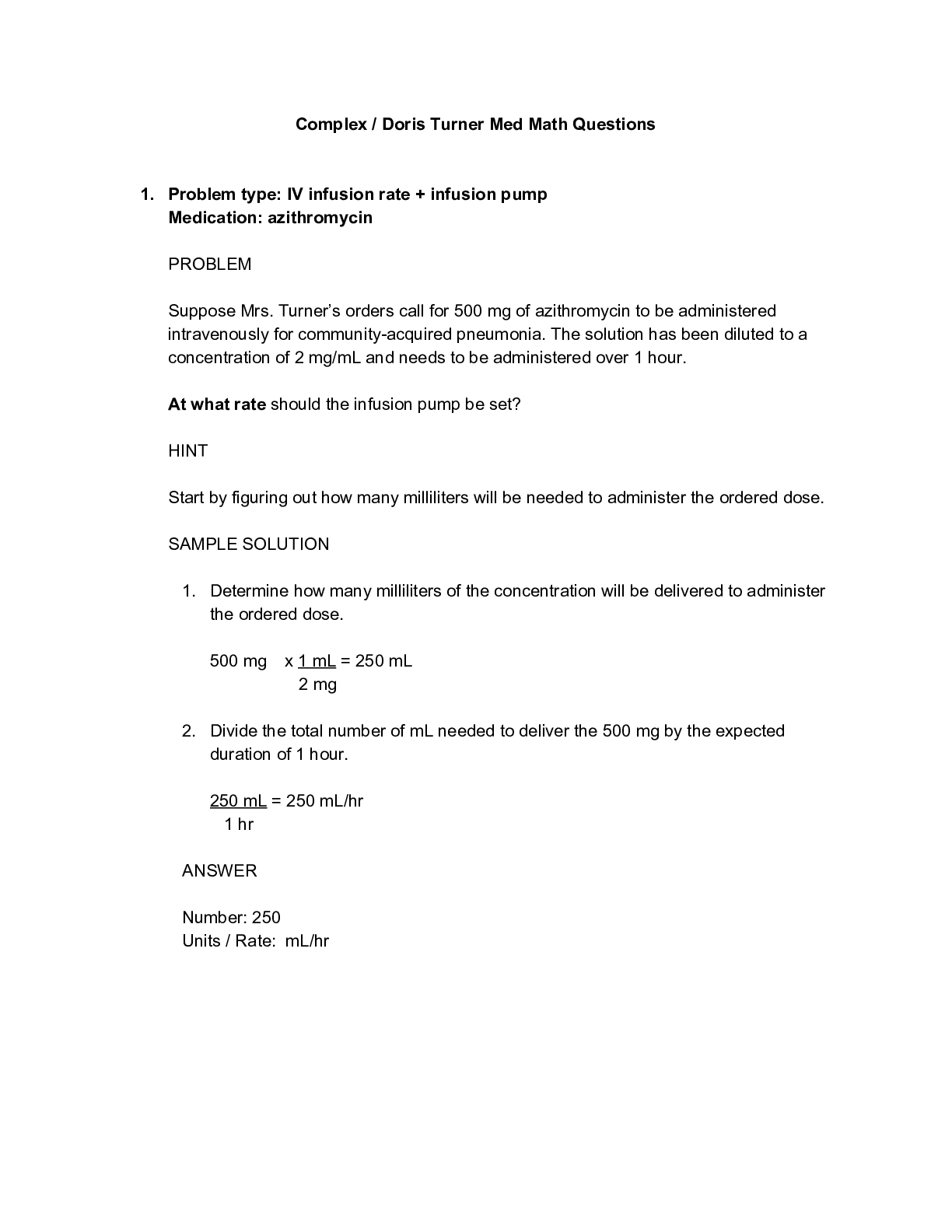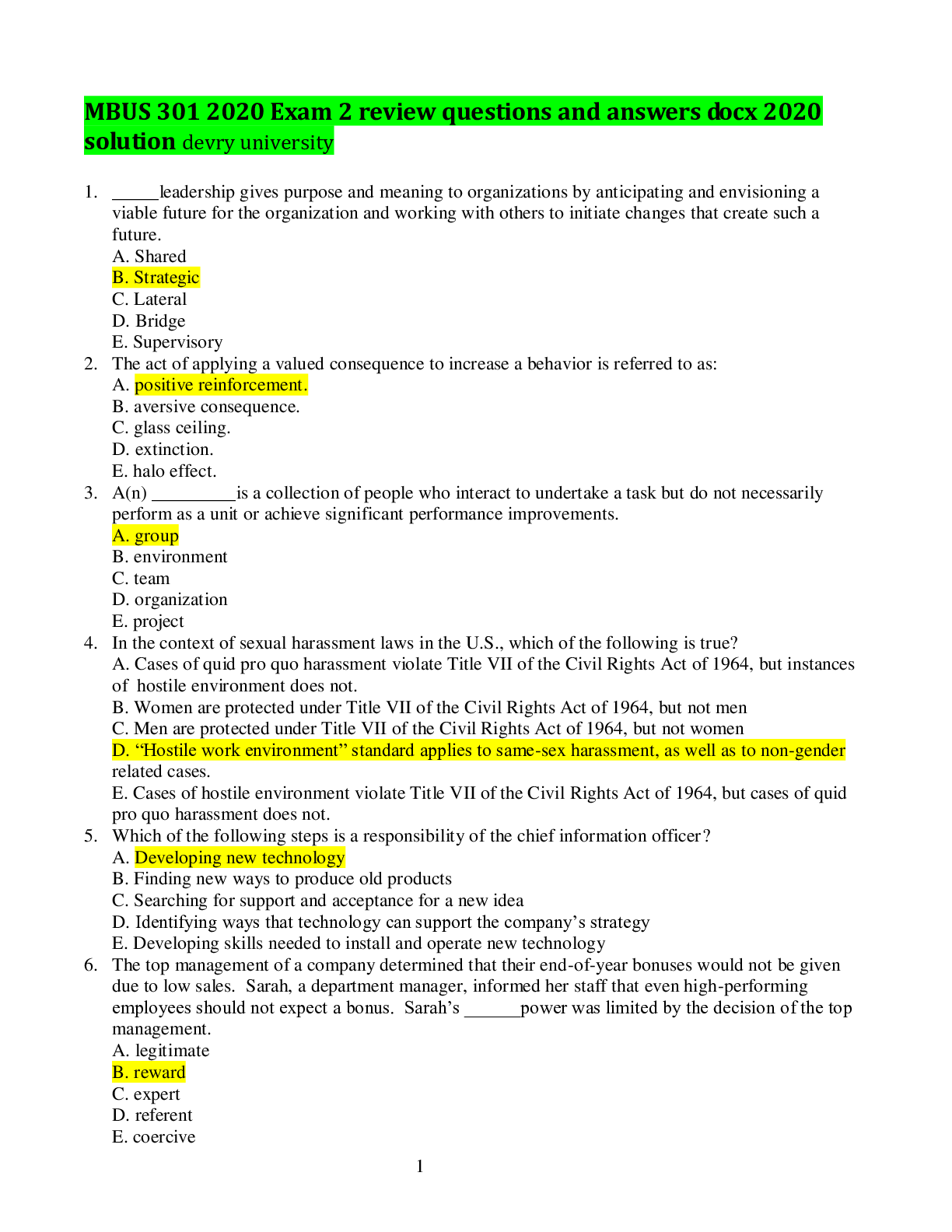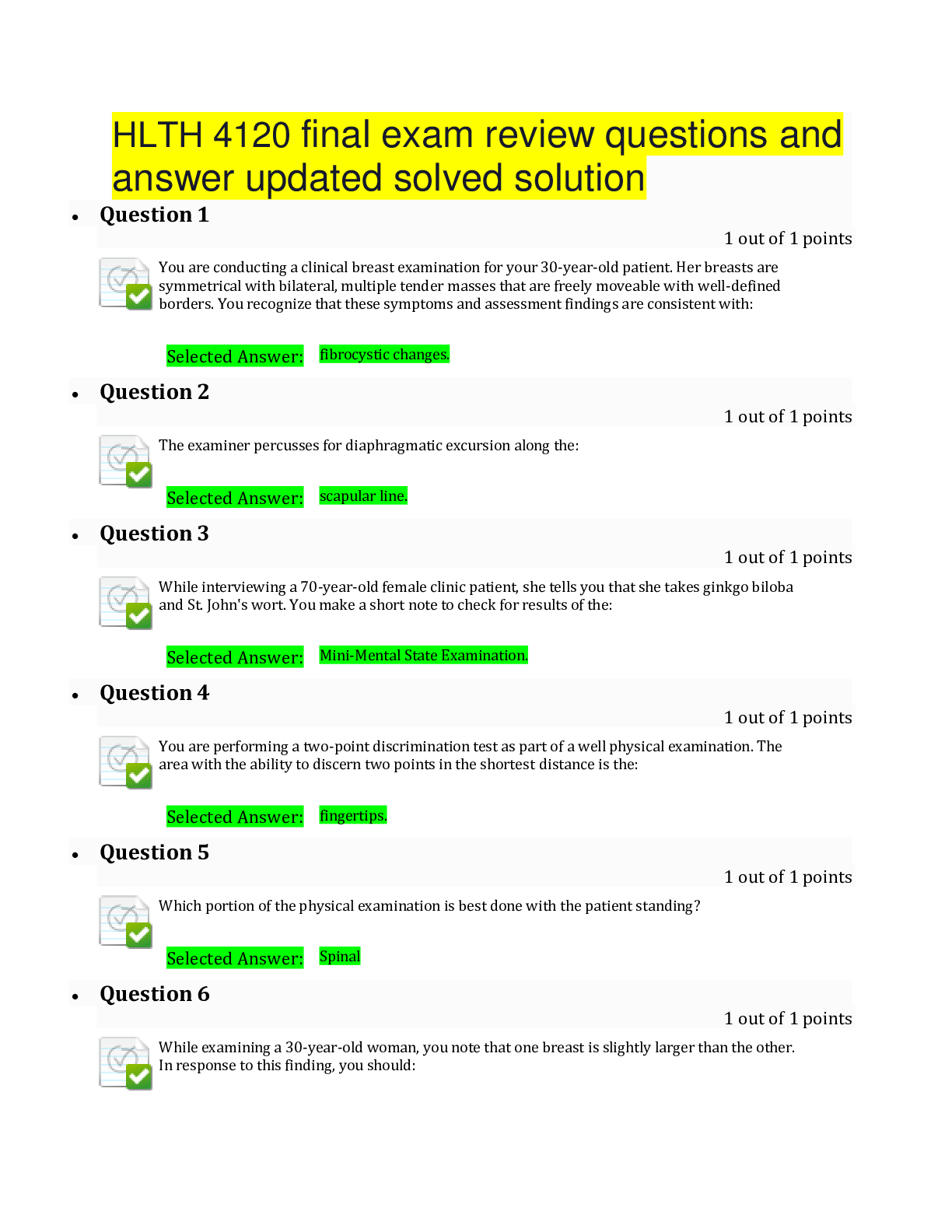*NURSING > QUESTIONS & ANSWERS > NR 511 - Week 3: Davis Edge Skin Review Questions and Answers (100% Correct) A+ Guide (All)
NR 511 - Week 3: Davis Edge Skin Review Questions and Answers (100% Correct) A+ Guide
Document Content and Description Below
Davis Edge Skin Review Questions A 22-year-old African American female presents to your family practice office complaining of progressive skin discoloration. She is adopted and has no known family h... istory of skin problems. The patient notes nonpalpable patches of skin loss and blanching of her forehead and both hands and feet. It has developed over a period of 6 months and appears to have stopped. It is not pruritic, and there is no erythema or sign of infectious etiology. What is the most likely diagnosis? Vitiligo- This is the physical description of vitiligo. Alopecia Alopecia involves hair loss, not skin discoloration. Addison Disease This condition involves hyperpigmentation of the skin, not hypopigmentation of the skin. Tinea Versicolor This refers to hypopigmentation of the skin due to a fungal infection and is noticed mostly after sun exposure. Which presentation is most concerning for skin cancer? Dark pigmentation of 1 solitary nail that has developed quickly and without trauma. This is concerning for acral melanoma A 1-mm blue, round, nonpalpable discoloration of the skin that has been present since birth without change. This describes a benign blue nevus, common in patients of Asian descent. A 5-mm black mole with round, regular boarders. This mole is round, regular, less than 6 mm, and without change; it is likely benign. A 2-mm brown mole that is raised 1 mm but round and regular. This mole is small, regular, minimally raised, and only 1 color; it is likely benign. A 4-year-old male presents to your pediatric clinic with his mother complaining of an itchy rash, mostly between his fingers. This has been going on for multiple days and has been getting worse. The patient recently started at a new day care. On physical exam, the patient is afebrile and has multiple small (1-2 mm) red papules in sets of 3 located in the web spaces between his fingers. He also has signs of excoriation. What is the treatment for this problem? Permethrin lotion for the patient and also his family members. – This is the treatment for scabies Cold compresses and hydrocortisone cream 1% twice a day. - This would decrease inflammation but would not cure the scabies. Over-the-counter Benadryl cream. This would provide itching relief but would not cure the scabies. Ketoconazole cream. This would treat a fungal infection, not scabies. Which of the following patients would not be at risk of Candida infection? A patient with a history of coronary artery disease. Coronary artery disease doesn’t increase the risk of Candida infection. A diabetic patient. Diabetes increases the risk of Candida infection. A patient requiring home antibiotics while recovering from an operation for an infected hernia. Use of long-term antibiotics increases the risk of Candida infection. A patient using a steroid regimen for asthma control Use of long-term steroids increases the risk of Candida infection. A 3-year-old patient presents to your pediatric office with her mother. She has recently been started in day care. Her mother noted slight perioral erythema on the right side of the patient’s mouth prior to bed last night. The patient awoke today with 3 small, superficial, honey-colored vesicles where the erythema was last night. The patient has no surrounding erythema. She had no difficulty eating this morning and is active and energetic and doesn’t appear lethargic or fatigued. She is also afebrile. How would you treat this child? Local debridement and mupirocin for 5 days. This is the treatment of choice for impetigo. Oral Keflex for 7 days. This is for more severe cases in which the patient is febrile. Topical compress with Burow solution and follow-up in 2 to 3 days. This compress would help but would not prevent bacterial spread. Local debridement and topical compress with Burow solution and close follow-up. This would help as well but wouldn’t prevent bacterial spread. A 22-year-old college student presents to your urgent care clinic complaining of a rash. She was recently on spring break and spent every night in the hot tub at her hotel. On physical exam, she has multiple small areas of 1- to 2-mm erythematous pustules that are present mostly where her bathing suit covered her buttocks. What is the most likely pathogen causing these lesions? Pseudomonas aeruginosa. This is a common cause of hot tub folliculitis. Klebsiella. This could be a cause of folliculitis in an immunocompromised patient. Staphylococcus aureus. Gram-positive bacteria can cause folliculitis, but this is not the most common pathogen found in a hot tub. Streptococcus. Gram-positive bacteria can cause folliculitis, but this is not the most common pathogen found in a hot tub. Which human papillomavirus serotypes most commonly cause cancer? Serotypes 16 and 18. – Cause Cancer Serotypes 6 and 11. Cause genital warts Serotypes 3 and 10. Cause flat warts Serotypes 27 and 29. Cause plantar warts A 27-year-old female comes in to your primary care office complaining of a perioral rash. The patient noticed burning around her lips a couple days ago that quickly went away. She awoke from sleep yesterday and noticed a group of vesicles with erythematous bases where the burning had been before. There is no burning today. She is afebrile and has no difficulty eating or swallowing. What test would confirm her diagnosis? Tzanck smear. This would show giant cells consistent with herpes simplex virus. Potassium hydroxide (KOH) prep. This is used to diagnose fungal infections. Exam under a Wood lamp. This is used to diagnose fungal infections. Sterile culture sent for aerobic and anaerobic bacteria. This would help with bacterial causes of these lesions; a polymerase chain reaction (PCR) would have to be sent to diagnose herpes simplex. Which condition is not included in the atopic triad? Aspirin sensitivity This is included in the ASA, or Samter, triad, which also includes nasal polyps and asthma. Asthma This is included in the atopic triad. Allergic Rhinitis This is included in the atopic triad. Eczema This is included in the atopic triad. A 16-year-old male presents to your office. He was sent by an orthopedist. He has recently had surgical fixation of a humerus fracture. The patient has been going to physical therapy and has been developing a rash on his arm after therapy that disappears shortly after returning home. He does not have the rash prior to therapy. The patient denies fevers and chills, and his incision is well healed, with no signs of infection. Of note, the patient has been experiencing more hand edema than the average patient and has had edema wraps used at the end of therapy to help with his swelling. The wraps are made of a synthetic plastic material. The rash the patient gets is erythematous and blotchy, not raised; it is on the operative upper extremity. What is the most likely diagnosis? Contact dermatitis The patient’s history and rash are consistent with a latex or plastic sensitivity due to the edema wraps used in therapy. Atopic dermatitis The patient’s rash is not consistent with eczema, which is dry and erythematous and usually found in the skin folds and around the eyes. Seborrheic dermatitis The patient’s rash is not consistent with seborrheic dermatitis, as no greasy yellow scales are present. Psoriasis Psoriasis is typically described as silvery scales on top of an erythematous, raised base. [Show More]
Last updated: 2 years ago
Preview 1 out of 30 pages

Buy this document to get the full access instantly
Instant Download Access after purchase
Buy NowInstant download
We Accept:

Reviews( 0 )
$15.00
Can't find what you want? Try our AI powered Search
Document information
Connected school, study & course
About the document
Uploaded On
Jul 14, 2021
Number of pages
30
Written in
Additional information
This document has been written for:
Uploaded
Jul 14, 2021
Downloads
0
Views
67





















 ans.png)

 answers.png)
, 100% Correct, Download to Score A.png)

